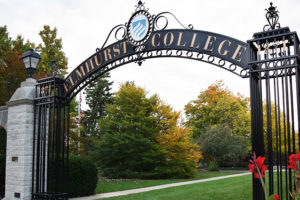
Despite significant progress in diagnosing and treating cancer, medical researchers are not close to finding a single cure, a celebrated oncologist and author said in a Science Talks lecture on February 19.
A more likely scenario is the continued development of drugs that slow the growth of cancers and reduce them to a chronic state. These treatments often enable patients to live another 10 to 15 years, according to Siddhartha Mukherjee, a cancer physician, medical professor at Columbia University and author of the Pulitzer prize-winning book, The Emperor of All Maladies: A Biography of Cancer.
Efforts to cure cancer are complicated by there being so many different forms of the disease. Only in the past 20 years have researchers scratched the surface in understanding cancer cells and how to control them, he said during his talk, part of the Roland Quest Lecture series.
“Pre-cancerous genes are in all of us, and with the right set of mutations they can be triggered by carcinogens, such as tobacco,” Mukherjee told an audience of nearly 1,000 in Hammerschmidt Memorial Chapel. Medical science has identified 120 mutations of breast cancer alone, and Mukherjee said one drug couldn’t possibly work on all of them. He is optimistic that scientists will be able to create families of chemical treatments that can be designed for specific forms of cancer in targeted therapy.
Mukherjee’s book traces the history of cancer to hieroglyphics on a 2500 BC Egyptian papyrus that depict a bulging mass on a woman’s breast. Centuries later, the Greek physician Hippocrates described it as carcinos, or a crab, because tumors were shaped like crabs, with the spreading of the disease resembling the legs. Romans later translated the word into cancer.
By the time a tumor resembled a crab, however, doctors were viewing advanced stages of cancer, he said. Today, cancer is detected much sooner, and doctors are more likely to find small lumps in a pre-cancerous stage.
For centuries, though, the common practice was to attempt to remove cancer surgically. Advancements enabled doctors to remove more and more tissue, but that radical approach often resulted in patients dying from the severity of the surgery. Now, doctors try to remove as little tissue as possible and treat cancer with chemotherapy, radiation and medicine.
False hope for a generic cure
It wasn’t until 1948, when Harvard researcher Sidney Farber began experimenting with drugs that could block the growth of cancer that caused acute leukemia, that medicine for treating and curing cancer showed promising results that led to the development of chemotherapy.
Prior to that, leukemia was 100 percent fatal. But by 1960 it was 30 percent curable, and by 1969 it was up to 80 percent curable in children through a variety of treatments. That progress, combined with the euphoria of sending men to the moon in 1969, generated false hope that a generic cure for all types of cancer was less than 10 years away.
Mukherjee said that “moon shot for cancer” fell far short, mainly because science had little understanding of what causes cancer cells to grow.
Even with ongoing advances in the understanding of cancer and the ability to treat it, he cautioned, we should not to expect dramatically higher survival rates in the near future: “We have been fooled before.”
One in three women in the U.S. and half the men will be diagnosed with cancer during their lifetime, and one out of four Americans—about 600,000 per year—will die of cancer. Yet the federal government spent far more on the war in Iraq than the war on cancer, he noted.
The combined annual budgets of the federal Food and Drug Administration and the National Cancer Institute—the agencies most involved with cancer research and treatment—is about $12 billion. The U.S. spent more than that on the Iraq war during some months in 2008 and 2009, Mukherjee said.
“When I am asked if we are spending too much on cancer research, I remind them of these numbers,” he said.